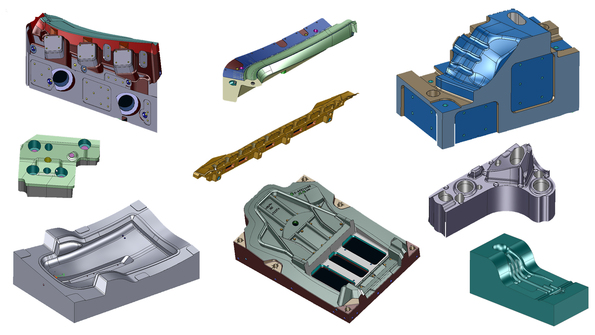How a CAD template truly simplified my CAM programming
→ Use a template to accelerate your CAD data preparation
→ Part preparation in record time: Using the CAD template
→ Only one template for many parts: Does this really work?
→ Faster from design to finished part with "CAD for CAM"
→ Free test: Demo using your part
I really enjoy working with CAD/CAM, but I'm a bit lazy when it comes to data preparation. Especially when it's always the same procedure: Importing data, placing zero points, defining blanks, positioning clamping devices, generating closing surfaces and outline curves… Would you like to avoid or quickly complete these standard tasks too ?
I enjoy using templates to save time in my work. It's ingenious to have a CAD template data preparation in the background for me . As a big fan of template-based CAM programming, it was clear to me: Most standard tasks in CAD data preparation are also best suited to automation.
- The same relatively simple tasks are repeated again and again
- They’re necessary, but they slow down the process with extensive manual work
- They’re also performed for other parts
- They proceed in sequence in the CAD/CAM system
I actually already had a working CAD template for my part. The software only prompts for one or two parameters and automatically produces the geometric results as the basis for CAM programming. And to be honest, it’s much faster than I can do it manually. Take a look at the video: Data preparation in 20 seconds.
The CAD template even takes care of organization for me. Element selection places the results directly in the right CAM folders: It's pure genius. Then my CAM templates can automatically continue processing there. I call it "CAD for CAM" for short; in other words, automatic CAD preprocessing for automated CAM programming and faster manufacturing.
My CAD template was a perfect match and so were the linked CAM templates. This simplifies CAM programming enormously. The templates are now saved in our favorites and are regularly used.
What used to cost me a lot of time and stress in other CAD and CAM software I can now do with automatic data preparation through a single mouse click.
It's no joke: My colleagues also save time when creating their parts. Everyone can do it after just two hours of training. This means you can also benefit from template technology for your parts: Less work and more time for other tasks.
- Create and transform axis systems
- Create the blank, finished part and clamping devices
- Detect threads and fits
- Transfer results directly to the CAM world
- Prepare different parts
Let me show you how you also can benefit.
Start saving lots of time now with your own CAD template!
Absolutely: Yes, it does. Even in single-part manufacturing. Although I often hear: "Oh, you and your templates. The parts we have are too different, so it won't work." But that's only true to a certain extent. There are always common elements. Here's a simple example: Whether it includes many prismatic or free-form elements, every part always needs clamping devices and a zero point. Always. And that's precisely where the CAD template works. Parts also have other common elements, like their geometries and machining operations. I’m sure this is true in your portfolio as well.
Of course, not all design measures can be automated. For me, it's certainly not about 100% automation; that would be meaningless. It's better to reasonably build up CAD/CAM automation. Step by step. And of course, it's also important to retain certain freedoms. For example, I want to be able to independently intervene in guide curves or limitation surfaces. So you have to be flexible, despite having the templates. This works perfectly with Tebis.
In fact, you can also store relevant machining information from the CAM world in the CAD template for every part class. This is then automatically accounted for in data preparation in CAM. CAM programmers, templates and machine operators: of course, they continue working with the same information – "CAD for CAM."
It works even better when the parts are similar in their geometry and machining operations. For example, see the graphic. We call these divisions "part classes."
Building on each other, CAD/CAM templates positively affect the overall manufacturing process. Your parts will get from CAD to finished part up to 95% faster. Sound exciting? CAD data preparation is just the first step. You can find more details here: 7 CAD/CAM process stations that can easily be automated.
OK, it sounds good in theory– but will CAD/CAM templates also work for you? Just try the practical test. In the demo, we'll work with you live to test this template technology. Preferably with a typical part that you’re familiar with . Experience shows that this makes it easier for demo participants to understand the steps and time savings. And what can I say: So far, everyone has responded enthusiastically. Try it for yourself.
Tebis CAD/CAM technology is extremely efficient: Give it a try!
👉 Join us by doing demo 👈
It's free, and we promise you’ll have an “aha” moment!

- Fill out the form.
- We'll contact you by phone, clarify key data and arrange a time.
- We'll spend one hour making your part.
- We'll work live and transparently online.
- You'll see the result during the meeting.
- Ask questions.
All this at no cost for you!






